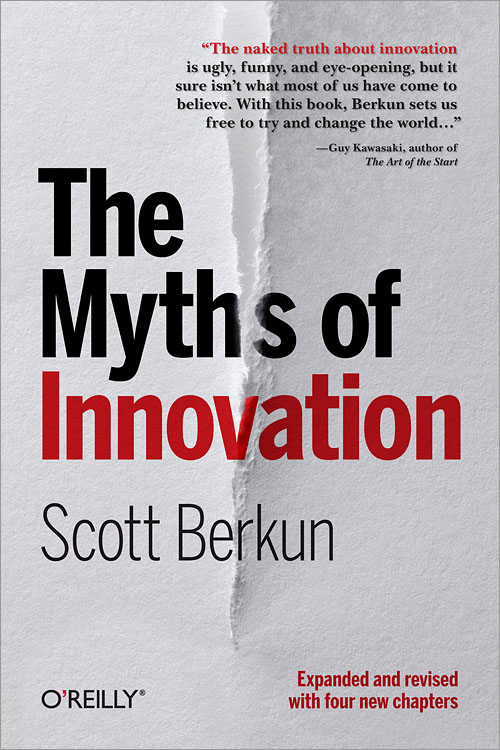The Many Mothers of Invention
[This is an excerpt from chapter 3 of the bestseller, The Myths of Innovation]
All the clichés about beginnings are true, at least in part. The history of innovation is large enough that all the sayings, from Plato’s famous “Necessity is the mother of invention” to Emerson’s “Build a better mouse- trap and the world will beat a path to your door” hold some truth. The trap, and the myth, is that evidence supporting one claim doesn’t mean there isn’t equally good evidence supporting another. Invention, and innovation, have many parents: the Taj Mahal was built out of sorrow, the Babylonian Gardens were designed out of love, the Empire State Building was constructed for ego, and the Brooklyn Bridge was motivated by pride. Name an emotion, motivation, or situation, and you’ll find an innovation somewhere that it seeded.

However, it’s simplifying and inspiring to categorize how things begin. In reading the stories behind hundreds of innovations, some patterns surface, and they’re captured here in six categories. I concede to the existence of reasonable arguments for seven or five, or different categorizations altogether. I offer this list to seed your thoughts on what paths to innovation are in front of you now.
1. Hard work in a specific direction
The majority of innovations come from dedicated people in a field working hard to solve a well-defined problem. It’s not sexy, and it won’t be in any major motion pictures anytime soon, but it’s the truth. Their starts are ordinary: in the cases of DNA (Watson and Crick), Google (Page and Brin), and the computer mouse (Englebart), the innovators spent time framing the problem, enumerating possible solutions, and then began experimenting. Similar tales can be found in the origins of the developments of television (Farnsworth) and cell phones (Cooper). Often, hard work extends for years. It took Carlson, the inventor of the photocopier, decades of concentrated effort before Xerox released its first copying machine.
2. Hard work with direction change (Pivot)
Many innovations start in the same way as mentioned previously, but an unexpected opportunity emerges and is pursued midway through the work. In the classic tale of Post-it Notes, Art Fry at 3M unintentionally created weak glue, but he didn’t just throw it away. Instead, he wondered: what might this be good for? For years he kept that glue around, periodically asking friends and colleagues whether it could be useful. Years later, he found a friend who desired sticky paper for his music notations, giving birth to Post-it Notes. Teflon (a mechanical lubricant), tea bags (first used as packaging for loose tea samples), and microwaves (unexpected discharge from a radar system) all have similar origination stories. What’s ignored is that the supposed “accident” was made possible by hard work and persistence, and it wouldn’t have otherwise happened by waiting around.
3. Curiosity
Many innovations begin with bright minds following their personal interests. The ambition is to pass time, learn something new, or have fun. At some point, the idea of a practical purpose arises, commitments are made, and the rest is history. George de Mestral invented Velcro in response to the burrs he found on his clothes after a hike. He was curious about how the burrs stuck, put them under a microscope, and did some experiments. Like da Vinci, he found inspiration in the natural world, and he designed Velcro based on the interlocking hooks and loops of the burrs and his clothing. Linus Torvalds began Linux as a hobby: a way to learn about software and explore making some of his own.10 Much like the direction-change scenario, at some point, a possible use is found for the product of curiosity, and a choice is made to pursue it or follow curiosity elsewhere.
4. Wealth and money
Many innovations are driven by the quest for cash. Peter Drucker believed Thomas Edison’s primary ambition was to be a captain of industry, not an innovator: “His real ambition…was to be a business builder and to become a tycoon.” Drucker also explains that Edison was a disaster in business matters, but that his profile was so prominent that—despite his entrepreneurial failures—his management methods are emulated today, particularly in Silicon Valley and venture capital firms.
With half an innovation in hand, ideas but no product, it’s natural to try to sell those ideas: let someone else take the risks of complete innovation. Instead of idealistic goals of revolution or changing the world, the focus is on reaping financial rewards without the uncertainties of bringing the ideas all the way to fruition. The Internet boom and bust of the 1990s was driven by start-up firms innovating, or pretending to innovate, just enough for established corporations to acquire them. In many cases, the start-ups imploded before acquisition or were acquired only for their ideas to be abandoned by the corporations’ larger and conservative business plans.
The founders of many great companies initially planned to sell their ideas to larger corporations but, unable to sell, reluctantly chose to go it alone. Google tried to sell to Yahoo! and AltaVista, Apple to HP and Atari, and Carlson (photocopier) to nearly every corporation he could find.
5. Necessity
Waves of innovation have come from individuals in need of something they couldn’t find. Craig Newmark, the founder of Craiglist.org, needed a way to keep in touch with friends about local events. The simple email list grew too popular to manage and evolved into the web site known today. Similarly, the founders of McDonald’s developed a system for fast food production to sim- plify the management of their local homespun hamburger stand (Ray Crok bought the company later and developed it into a multinational brand). Innovations that change the world often begin with humble aspirations.
6. Combination
Most innovations involve many factors, and it’s daft to isolate one above others. Imagine an innovation that starts with curiosity and leads to hard work, but then the innovator’s quest for wealth forces a direction change. Midway through, this direction change is interrupted by a stroke of good luck (say, winning the lottery), allowing the innovator to return to the initial direction with renewed perspective and motivation. The removal of any of those seeds from the story might end it—or might not. In many of the stories of innovation, we have to wonder: if the first “magical” event didn’t take place, might the innovator have found a different seed instead? No matter what seeds are involved, all ideas overcome similar challenges, and studying them reveals as much or more than the beginnings of innovation.
The challenges of innovation
Steve Jobs, founder of Apple and Pixar, was asked, “How do you systematize innovation?” (a common question among CEOs and the business community). His answer was, “You don’t.” This was not what readers of Business Week expected to hear, but foolish questions often receive disappointing answers. It’s as absurd a question as asking how to control weather or herd cats, because those approximate the lack of control and number of variables inherent in innovation. Jobs, or any CEO, might have a system for trying to manage innovation, or a strategy for managing the risks of new ideas, but that’s a far cry from systematizing something. I wouldn’t call anything with a 50% failure rate a system, would you? The Boeing 777 has jet engines engineered for guaranteed 99.99% reliability—now that’s a system and a methodology. It’s true that innovation is riskier than engineering, but that doesn’t mean we should use words like system, control, or process so casually.
To read more about the challenges of innovation, and how to overcome them, get a copy of The Myths Of Innovation.


Hi there Scott,
My opinion is that fundamentally innovation is a construct of external stimuli.
Jack Ma figured with the advent of the internet, globalization and China’s rising manufacturing prowess Alibaba.com was what the market needed. An intuitive, but at that time innovative move connecting buyers and sellers. He was only able to do so after visiting the USA. A different environment stimulated him enough to lead him to that idea.
Steve Jobs didn’t think of a mouse until he visited Xerox Parc. That wasn’t his invention but with his marketing genius it became a key part of personal computing.
These fall within what you have written above.
Cheers,
Akash
A key to innovation and leadership is the willingness to stick out and create disruption. You can challenge current ideologies as things often occur slowly and on a small scale. This allows individuals to refine and learn from failure. The important step is to remain persistent and avoid giving up to quickly.